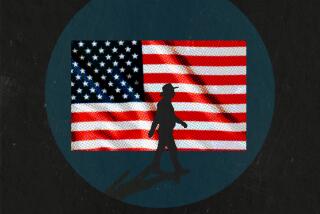Mexicans Excluded From Stamps
- Share via
Re “Stamp of Approval for Mexicanos,” Commentary, Jan. 3: “The Southwest is still Mexico,” writes Jose Antonio Burciaga. Actually, it isn’t.
It is true that Spanish claims to the Southwest date to the 16th Century. However, while Spain carried out extensive settlement in Mexico, its leaders left the lands north of the Rio Grande virtually untouched. Early in the 1800s, three centuries after the coming of the Spaniards, the largest town in the Southwest was Santa Fe, population 6,000. The second-largest, San Antonio, had a population of 1,500. Mexico had settled California so thinly that a force of barely a hundred troops, led by John Fremont, sufficed to win this entire state for the U.S.
Within the entire Southwest, the Mexican legacy now offers little more than place names. Its present-day Hispanic population represents a recent development, occurring long after these lands came under the U.S. flag. There is no basis in history for the claim of Burciaga, for in fact the Southwest held so few people, after 1800, that it would inevitably go to the nation whose people would first arrive in large numbers. And that nation proved to be the United States. It might have been Mexico, but it wasn’t.
T. A. HEPPENHEIMER
Fountain Valley
* How could Mexicans be ignored in acknowledging the settlement and development of the West? Once again, this underscores the need to have more than a “mainstream” perspective on historical data.
Certainly, this was an issue among those professors and students who chose to fast in favor of a Chicano Studies program at UCLA in the spring of 1993. But it doesn’t take one from academia to see it’s the one who writes the history books who determines who and what are historically significant (or insignificant). Exclusion, whether covert or overt, is a cruel extension of racism.
It is clear that some of our non-Latino neighbors would rather close their eyes and pretend we don’t exist.
FERNANDO PEREZ
Lakewood
* Burciaga mentions Charles Goodnight, who he describes as “a Texas Ranger, ‘Indian fighter’ and pioneer cattle rancher,” and says, “Considering the reputation of the Texas Rangers, it’s interesting that he is not acknowledged as a Mexican-fighter, but ‘Indian fighter’ says it all.”
I am a descendant of Charlie Goodnight and American Indians. I take umbrage at Burciaga’s uninformed, snide slander. The record shows that Charlie fought Comanches in West Texas, not Mexicans. Is Burciaga trying to say that Mexicans are the same as North American Indians?
Old Charlie’s ancestors go all the way back on this continent to 1752, and shortly after that to the Kentucky of Daniel Boone. Charlie served in his mid-20s with the Texas Rangers during the Civil War, when the Comanches attacked western pioneers of a distracted Texas. The wild frontier area of west Texas and east New Mexico had a history of attack and counterattack between Indians, Hispanics and Norteamericanos . I am not proud that my ancestor might have shared even briefly in this, but this is not why he is famous, any more than George Washington is famous for killing British soldiers. It was Charlie’s “rugged individualism” as a stubborn yet principled cattleman who lived to be 93 in a very rough and wild land, and in blazing three different cattle trails, one reaching all the way to Cheyenne, Wyo.!
I have learned fluent Spanish as an adult, and respect, honor and enjoy the contributions made to this state and nation by Spanish-speaking peoples. I also honor the contribution of Chinese, Irish, African, German, Japanese and other ethnic groups from around the world. I am sorry that the postage stamp series “Legends of the West” did not include a Spanish-speaking American, and hope this will be corrected.
GLEN H. GOODKNIGHT
Monterey Park
More to Read
Sign up for Essential California
The most important California stories and recommendations in your inbox every morning.
You may occasionally receive promotional content from the Los Angeles Times.










